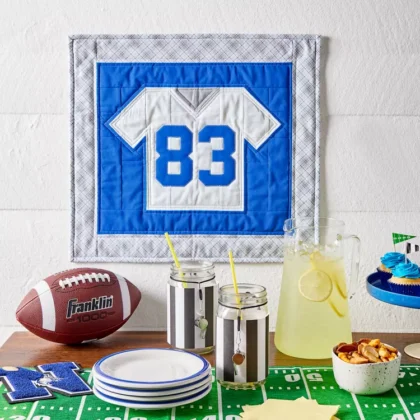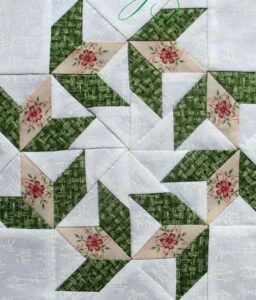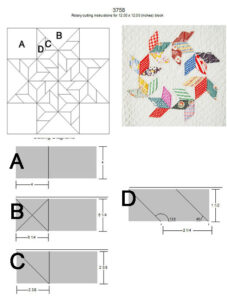
The Circling Swallows Quilt Block is a stunning and dynamic quilting design that has captured the hearts of quilters around the world. This eye-catching block features a pattern reminiscent of birds in graceful flight, swirling in a circular motion that adds movement and sophistication to any quilt. Whether you’re a beginner or an experienced quilter, incorporating this block into your projects can elevate your creations with elegance and flair.
One of the reasons the Circling Swallows Quilt Block is so popular is its visual rhythm. The repeated motion of the “swallows” circling around the center of the block creates a beautiful sense of harmony and flow. This makes it not only a wonderful choice for full quilts but also for accent pieces like wall hangings, table runners, or even pillow covers.
This article will guide you through everything you need to know about this charming quilt block, from design ideas and piecing techniques to color choices and layout tips. We’ll explore different ways to use the Circling Swallows Quilt Block in your quilting projects, ensuring you’re equipped with both inspiration and practical knowledge.

IMAGE FROM PINTERST
The Circling Swallows Quilt Block is based on symmetry and movement, often featuring triangular or wing-shaped pieces arranged in a circular pattern.
This block relies on precision. Each swallow shape must be cut and placed carefully to maintain the overall circular effect, which gives the block its distinct and dynamic appearance.
A traditional version of the block often uses contrasting colors to highlight the circular motion, usually with light and dark fabrics alternating to simulate motion and depth.
Quilters can modify the block to suit different themes by changing the fabric prints or incorporating fussy cutting to showcase specific motifs within the shapes.
While the design may look complex at first glance, it can be broken down into simpler units such as half-square triangles or flying geese blocks, making it more approachable even for intermediate beginners.
The block typically finishes at 12 inches but can be resized according to your quilt layout, offering flexibility for both large and small projects.
Before starting your Circling Swallows Quilt Block, gather essential quilting tools to ensure accuracy and efficiency.
You’ll need a rotary cutter, quilting ruler, and self-healing cutting mat to make clean, precise cuts. These tools are vital for achieving the block’s symmetry.
Fabric selection is key—choose a mix of solid and patterned fabrics with contrasting tones to bring out the swirling motion of the swallows.
A sewing machine with a ¼ inch presser foot helps maintain consistency in seam allowances, which is crucial for the pieces to fit together perfectly.
Don’t forget to have pins or fabric clips on hand. These tools help keep layers aligned during piecing and pressing.
Finally, use a good quality iron and pressing board. Pressing seams as you go will ensure your block lays flat and looks polished.

IMAGE FROM PINTEREST
Start by cutting your fabric into the required shapes: triangles, squares, and rectangles, depending on the pattern variation you’re using.
Begin piecing the smaller units, such as half-square triangles, to create the individual swallow shapes. Precision is key here for the circular design to align properly.
Lay out your block pieces before sewing them together. This allows you to double-check color placement and orientation to ensure the swirling effect is intact.
Sew the block in sections—typically quadrants—then piece those sections together. This method reduces the chance of distortion and helps keep seams straight.
Press each seam carefully, always pressing toward the darker fabric when possible to avoid shadowing and bulk.
Once assembled, square up your block using a quilting ruler to make sure it’s the correct size and has clean edges, ready to be joined with other blocks.
The Circling Swallows Quilt Block isn’t just for traditional bed quilts—it works beautifully in a range of modern and decorative projects.
Create a wall hanging by framing a single block or combining a few to create a bold visual centerpiece in your home.
Use the block for a table runner by arranging several in a row, creating a sense of movement and elegance for your dining area.
Incorporate the block into throw pillows to add a handcrafted touch to your living space, perfect for showcasing intricate fabric patterns.
You can also use the Circling Swallows Quilt Block in tote bags or quilting journal covers, turning functional items into beautiful, personalized art pieces.
For a modern twist, consider using a monochromatic palette or rainbow gradient to reinterpret the block in a new and fresh way.
FAQ – Circling Swallows Quilt Block
Q1: Is the Circling Swallows Quilt Block suitable for beginners?
Yes, with clear instructions and some experience with basic quilt blocks like half-square triangles, beginners can successfully complete this block.
Q2: What size should the Circling Swallows Quilt Block be?
The most common finished size is 12 inches, but it can be resized to fit your project using scaling methods or pattern variations.
Q3: Can I use scraps for this block?
Absolutely! This block is a great way to use up fabric scraps, especially for the “swallow” sections. Just ensure contrast between the fabrics for the best visual impact.
Q4: How do I ensure the block stays square during assembly?
Careful piecing, consistent seam allowances, and pressing after each step help maintain the block’s square shape. Squaring up with a ruler after piecing is also recommended.
Q5: What quilting techniques pair well with the Circling Swallows Quilt Block?
Echo quilting or simple straight-line quilting enhances the block’s motion, while free-motion quilting can add texture and depth without distracting from the design.
Q6: How many blocks do I need for a full-size quilt?
It depends on the final block size and desired quilt dimensions, but typically, a full-size quilt might require 30–42 blocks. A layout diagram can help plan accurately.
The Circling Swallows Quilt Block is more than just a design—it’s a celebration of movement, symmetry, and creativity in quilting. From learning the structure and tools needed to exploring assembly tips and creative applications, this block offers endless possibilities for quilters of all levels. Whether you’re making a decorative piece or a full quilt, this pattern will surely add grace and interest to your work.